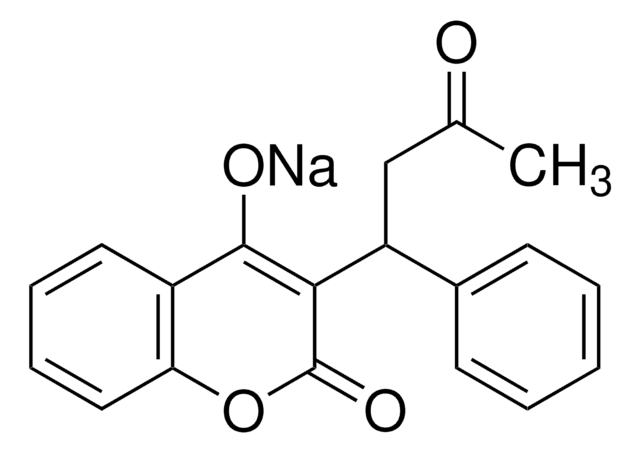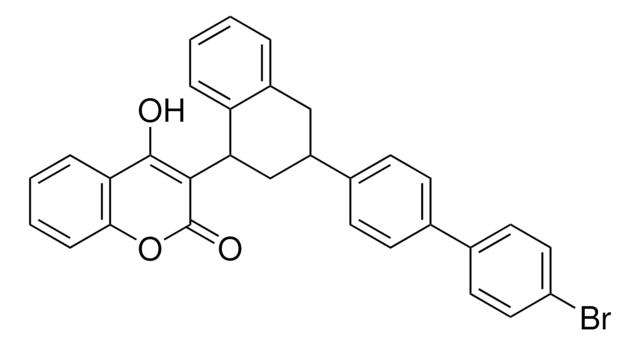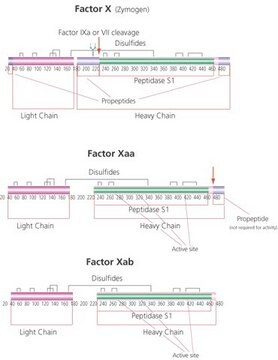Key Documents
1719000
USP
Warfarin
United States Pharmacopeia (USP) Reference Standard
Synonim(y):
4-Hydroxy-3-(3-oxo-1-phenylbutyl)coumarin, Coumafene
About This Item
Polecane produkty
klasa czystości
pharmaceutical primary standard
rodzina API
warfarin
producent / nazwa handlowa
USP
mp
162-164 °C (lit.)
Zastosowanie
pharmaceutical (small molecule)
format
neat
temp. przechowywania
2-8°C
ciąg SMILES
CC(=O)CC(c1ccccc1)C2=C(O)c3ccccc3OC2=O
InChI
1S/C19H16O4/c1-12(20)11-15(13-7-3-2-4-8-13)17-18(21)14-9-5-6-10-16(14)23-19(17)22/h2-10,15,21H,11H2,1H3
Klucz InChI
PJVWKTKQMONHTI-UHFFFAOYSA-N
informacje o genach
human ... VKORC1(79001)
Szukasz podobnych produktów? Odwiedź Przewodnik dotyczący porównywania produktów
Opis ogólny
Zastosowanie
- Warfarin Sodium
- Warfarin Sodium Tablets
- Warfarin Sodium for Injection
Komentarz do analizy
Inne uwagi
Informacje prawne
Hasło ostrzegawcze
Danger
Zwroty wskazujące rodzaj zagrożenia
Zwroty wskazujące środki ostrożności
Klasyfikacja zagrożeń
Acute Tox. 1 Dermal - Acute Tox. 1 Inhalation - Acute Tox. 2 Oral - Aquatic Chronic 2 - Repr. 1A - STOT RE 1 Oral
Organy docelowe
Blood
Kod klasy składowania
6.1A - Combustible acute toxic Cat. 1 and 2 / very toxic hazardous materials
Klasa zagrożenia wodnego (WGK)
WGK 3
Temperatura zapłonu (°F)
Not applicable
Temperatura zapłonu (°C)
Not applicable
Certyfikaty analizy (CoA)
Poszukaj Certyfikaty analizy (CoA), wpisując numer partii/serii produktów. Numery serii i partii można znaleźć na etykiecie produktu po słowach „seria” lub „partia”.
Masz już ten produkt?
Dokumenty związane z niedawno zakupionymi produktami zostały zamieszczone w Bibliotece dokumentów.
Klienci oglądali również te produkty
Nasz zespół naukowców ma doświadczenie we wszystkich obszarach badań, w tym w naukach przyrodniczych, materiałoznawstwie, syntezie chemicznej, chromatografii, analityce i wielu innych dziedzinach.
Skontaktuj się z zespołem ds. pomocy technicznej











